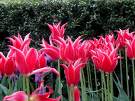 Flowering
bulbs are an essential component of the well planned
garden or landscape, adding interest and bright colors
in a way that shrubbery and other
herbaceous perennials cannot.
Flowering
bulbs are an essential component of the well planned
garden or landscape, adding interest and bright colors
in a way that shrubbery and other
herbaceous perennials cannot.
Like so many things
in horticulture, the term "bulb" has taken on all
kinds of meanings. A true bulb is a swollen underground bud formed from fleshy
scales or leaf bases which acts as a storage unit to enable various plants to rest in a
dormant state during part of the year. Bulbs include
tulips,
daffodils,
lilies (not
daylilies) and
alliums (ornamental onions),
iris (some species such as Iris reticulata
- others are
rhizomes), snowdrops (Galanthus)
among others.
Inside a bulb is a small preformed flower
called the flower primordium. Given the correct
environment, the flower primordia will mature, form
a flower bud and
bloom. Bulbs that fail to bloom are called "blind."
The flattened base of a true bulb is
called the basal plate. It is the area from which all
roots originate and should always be planted downward in
the soil. Last
year's withered stem may linger on the top side of the
bulb. An undamaged bulb is often covered by a thin
papery sheath or tunic.
Many other plant
tissues are commonly, but incorrectly, called bulbs
including corms
(crocus,
gladiolus,
windflowers,
Colchicum, Freesia, Elephant Ears [Colocasia]),
tubers
(potatoes),
tuberous roots
(dahlias,
tuberous begonias) or storage
roots (Canna).
Corms, from which crocus and
gladiolus grow, are actually swollen stems and have
nodes, internodes and lateral buds growing from the
nodes. A new corm forms atop the old one each year, and
clusters of small corms, called cormels, grow around the
base. Flowering stems grow from several buds on top of
the corm.
On very flat corms, such as those of
Anemone, it may be quite difficult to distinguish top
from bottom. Look for last year's shriveled stem, and
plant it upward.
Tuberous roots, such as tuberous begonias and
Dahlia, are swollen roots that have one to several eyes
at one end near the old stem. Unless an eye is present,
a tuberous root plant cannot grow.



